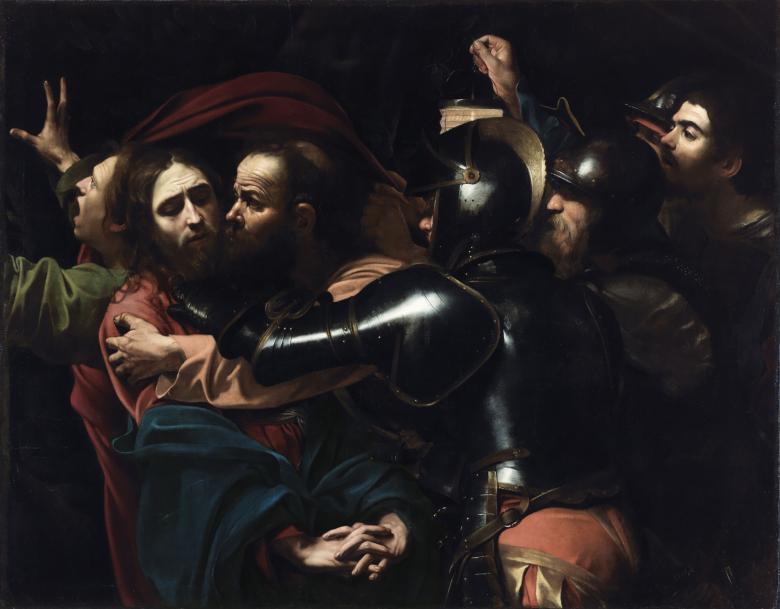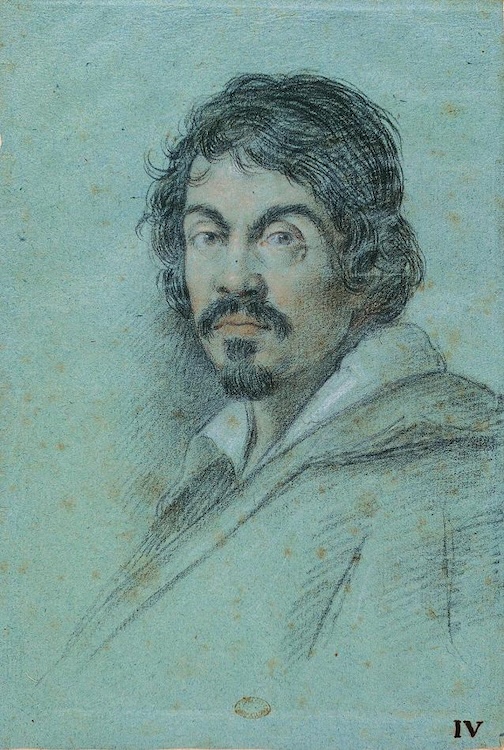There are seven men: a fleeing follower of Jesus, assumed by art experts to be St. John; the Incarnate God; His betrayer; three soldiers (one identifiable only by the gleam of his helmet); and, next to the left of that soldier, a man holding up a lantern, the light of which illuminates the scene. This last figure is significant because it’s a self-portrait of the artist.
That Caravaggio put himself in the painting surely tells us something about him, although not much. So, we’re left to speculate.
Perhaps he’s touting his role as a soldier in the battle against the Protestant Reformation. It doesn’t tell us that he saw himself precisely as the artistic leader of the Counter-Reformation (Controriforma or Contrareformatio), not least because that term is a 19th-century coinage. Therefore, two centuries in the future.
But in commissioning work from him, his patrons – clerical and otherwise (all or nearly all Catholic) – likely did speak to Caravaggio of the need to forcefully assert Catholicism against the sullen iconoclasm of Luther, Calvin, et alii, and the Northern European artists who were their followers.
And for Caravaggio, there was always the refutation of the rigidity and formalism of much Renaissance and post-Renaissance art of his Catholic predecessors. And I’m talking about the work of Leonardo, Michelangelo, Raphael, and the rest.
Caravaggio had a flair for drama; for scenes that capture not only images but also emotion and action – epochal moments, sometimes stark: beheadings and martyrdoms; callings and conversions. He was not alone in this, but he was best at it.
The moment of Christ’s arrest in Gethsemane – at the apex of history, as are all the events in Christ’s life we commemorated in Holy Week – may not be as popular a subject in art as are the dramas of the Last Supper, the Crucifixion, and the Resurrection, but it’s a powerful moment, and many artists have painted it, usually in frescos or canvases crowded with soldiers, Apostles, disciples, Pharisees, and bystanders.
Not Caravaggio. In The Taking of Christ, there are only those seven figures set against the night – figures we can see only because Caravaggio himself holds up a light. So forward are these figures in the picture frame, we almost become bystanders.
Is this his greatest painting? To my mind, no. That distinction belongs to his Supper at Emmaus. But The Taking of Christ is superb.
And nearly as remarkable as the painting itself is the story of its coming to Dublin’s National Gallery in 1992.

The work was commissioned by the Marquis Ciriaco Mattei in 1602, when Caravaggio was 31. The painting stayed in Rome for 200 years before it was sold. So much time had passed that the Mattei family had lost track of the painting’s provenance and had come to believe it was the work of Gerrit van Honthorst (1592-1656), a Dutch follower of Caravaggio. Scholars at that time assumed Honthorst had copied the original, as other painters had, and that’s what William Hamilton Nisbet thought when he bought the picture and took it home to Scotland.
In Edinburgh, the painting was three times sold at auction in the early 1920s, coming finally into the possession of Marie Lea-Wilson (née Ryan), a deeply religious Irish woman. She bought the painting – for less than £10. Her husband, a Royal Irish Constabulary officer, had been assassinated by the I.R.A. during the Easter Rising of 1916, and she hoped Honthorst’s depiction of the beginning of Christ’s Passion would provide solace in her mourning.
But mourning did not cause her to languish. She went to medical school at Trinity College, became a noted Dublin pediatrician, and attended Mass daily. And as the National Gallery of Ireland explains:
Dr. Lea-Wilson forged a strong connection with the Dublin Jesuit community, receiving great spiritual support from Father Tom Finlay at the Jesuit House on Leeson Street, which may explain her subsequent gift of the painting to them in the 1930s.
And this is where the story gets really interesting.
The painting was hung in the Jesuit House dining room, and one wonders how often a guest might have admired it.
“Goodness, Father, that’s a remarkable picture. It almost looks like a Caravaggio.”
“Heavens, it would be something if that were so. But, no, it’s by a Dutch fellow called Honthorst.”
And that was the story for the next half-century.
Then the Jesuits, who owned some other paintings besides the “Honthorst” decided it was time they got an expert opinion of the value of their modest collection. So, in 1990 Father Noel Barber, S.J. called the National Gallery, and soon conservator Sergio Benedetti, a native of Florence, Italy and a Caravaggio expert, dropped by Jesuit House to take a look.
As the Irish Times noted at the time of his death in 2018, Benedetti was “the right man in the right place.”
Prior to joining the National Gallery in 1977, he had become a specialist in 17th-century Italian painting, with a particular interest in Caravaggio and his followers. As a conservator, he was intimately acquainted with the very distinctive way Caravaggio worked, and he immediately suspected that he had seen the lost original of a painting known through many copies, and referred to by the artist’s contemporaries.
Why it had been attributed to Honthorst is unclear, but three years of research would confirm Benedetti’s certainty that this was a Caravaggio – and one of the artist’s true masterpieces.
The painting’s provenance is now described this way:
On indefinite loan to the National Gallery of Ireland from the Jesuit Community, Leeson St., Dublin, who acknowledge the kind generosity of the late Dr. Marie Lea-Wilson, 1992
The glimpse we get of the artist in the painting is intriguing. He put such self-portraits in several paintings, although he never did a mature, full-facing stand-alone. The only known portrait was done by his friend Ottavio Leoni (below), and it may be a good likeness, although Leoni made the drawing a dozen years after Caravaggio’s death.
















